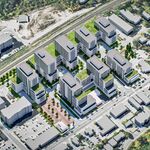salsa
Senior Member
Finally some positive news after an abysmal few weeks for road safety.
That's assuming they actually catch the driverThe province needs to make the penalty for hit and run collisions so huge no one will think about ever driving away again.
That's assuming they actually catch the driver
If it wasn't for this city being so cheap, I'd believe council approving this rather than implementing an actual Vision Zero plan.Forget straps - everyone should wear a 360 bodycam.
AoD
A reflective body camForget straps - everyone should wear a 360 bodycam.
AoD
Probably a combination of a few factors. SUVs are now much more popular and are clearly more deadly than sedans due to their increased mass. Our population is aging, and I expect that that's even more true of the suburbs than downtown. And finally, the police literally stopped enforcing traffic laws 6 years ago which has created a culture where drivers know they can break the law and nothing will happen to them as a consequence.Something I do not understand, has the speed on suburban arterials increased over say the past twenty years? Seems like pedestrian fatalities have spiked up in recent years. Assuming speed has always been "high", what caused the change? Sub-standard drivers? Aging population? Technology?
Probably a combination of a few factors. SUVs are now much more popular and are clearly more deadly than sedans due to their increased mass. Our population is aging, and I expect that that's even more true of the suburbs than downtown. And finally, the police literally stopped enforcing traffic laws 6 years ago which has created a culture where drivers know they can break the law and nothing will happen to them as a consequence.
My own theory is simply that as the roads fill up with cars, and as the number of stoplights per mile increase, people just get more impatient and make more risky manoeuvres more often than in the past. Examples:
- car ahead stops eg to make a turn, cars behind abruptly change lanes, instead of just waiting til the driver ahead has moved onn. The whole line of cars changes order because the car furthest back weaves first, drivers may be overtaking where there is a hazard
- racing for yellow lights is clearly happening more, possibly because there are many more stoplights
- turning aggressively while a pedestrian is still crossing - especially left turns - because there are few gaps in oncoming cars and the urge to ‘“give’er” overwhelms the requirement to yield... now or never dynamics
In all of these, the common element is “in a hurry”.... but the haste may not be increasing, rather, it’s the perception that the drive is taking longer than it used to or ought to.... which may be true. People need to recalibrate from earlier decades - but their need for speed is just habit, it’s not some newfound depravity or loss of human caring.

A common refrain directed at the driving public is 'check your blind spot, check your blind spot', specifically referring to what's beside and to the back of the vehicle. But where's the directives about checking the forward blind spot? Making a left/right turn, approaching a crosswalk, crossing an intersection... all are heavily obscured. With newer cars you really have to move your head forward/backward and side to side at all times, I mean a lot more than in older vehicles. Let's get some attention on that.
This is a good point!
Let me add, in respect of rear/side blind spots, why the hell are we still allowing cars with mirrors, we should be on rear-view and side view cameras with no blind spots. These could also aid in accident investigation.




